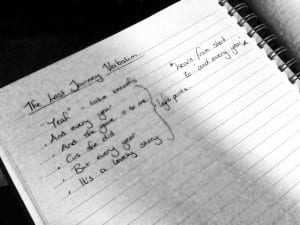In the show we have composed several scenes where we have used our interviews with relatives and local residents as verbatim. The purpose of verbatim has been described by Hammond as follows: “Instead of adapting or repackaging experiences or observations within a fictional dramatic situation, a verbatim play acknowledges, and often draws attention to, its roots in real life” (2008, p1). The idea being that you display the interviewee through the actor by imitating the person’s pauses, inflections in their voice and use the precise words that have been recorded. The idea of verbatim is to present a sense of authenticity because “if you go out and collect evidence about people’s way of life, things are revealed to you which are completely extraordinary that you don’t see coming”(National Theatre Discover, 2014); a truth that can be presented to an audience.
Some regard verbatim as a form of theatre however, as Hammond and Steward point out, it is a technique within theatre (2008, p1). This is due to the nature of verbatim as a source of information which can then be configured into a narrative creating a drama. The verbatim may be edited for a particular section of the interview or can be stylistically edited through the use of other sounds or rhythms. Within our show Lauren has devised a few ways in which we present the verbatim. Some pieces are the original recordings, some are simply spoken to the audience (this is the common feature for the verbatim from the letters we are using) and also we have taken inspiration from Dan Canham and Stillhouse’s performance with using audio devices like an Ipod where we listen to the recorded verbatim and speak whilst listening .
The piece of verbatim that was designated to me was by a lady from the Eastholme Care Centre. We came to name this piece ‘The Last Journey’. I worked very closely with Lauren to decipher the rhythm and pace of the verbatim. We soon realised that the piece was by far the fastest pace out of all the verbatim and so it took me a while to grasp everything the lady said. One piece of advice that Dan Canham gave us when using verbatim was to treat the verbatim as a rhythm. So once I had practised speaking with the lady and the pace, Lauren helped me break the piece down into sections where there were pauses in the speech or slight changes in pace. This helped greatly with translating the inflections in the lady’s voice in my own voice for the performance. Another note Dan emphasised was to not to learn the verbatim like lines from a play, the idea being that we embody the voice of the person, it was natural occurrence and not forced.
Speaking someone else’s words at first can seem very strange. I found that to begin with, I would just say the words in my own voice. It wouldn’t have much tone or emotion involved and very dull, hearing myself anyway! Gradually you have to forget about what your own voice sounds like and truly listen to the other person’s to be able understand what it is you’re trying to do with the verbatim. Every detail in the track matters; the pauses, the changes, the accent, the inflections. That is what makes the person and that is what you need to be able to portray the person to the audience. The person is manifested/transferred through you to the audience. Below is the audio track of ‘The Last Journey’ verbatim that I will be performing in the show and also a couple of links to Lauren’s posts on how she directed the verbatim in ‘Sincerely Yours’.
Links to Lauren Kirby’s (Director) blogs on Verbatim:
Works Cited:
Hammond, W. and Steward D. (eds.) (2008) Verbatim Verbatim: Contemporary Documentary Theatre, London: Oberon Books.
National Theatre Discover (2014) An Introduction to Verbatim Theatre [online video] Available from: https://www.youtube.com/watch?v=ui3k1wT2yeM, [Accessed 5th May 2014].
National Theatre Discover (2014) The Ethics of Verbatim Theatre [online video] Available from: https://www.youtube.com/watch?v=39JSv-n_W5U, [Accessed 5th May 2014].

